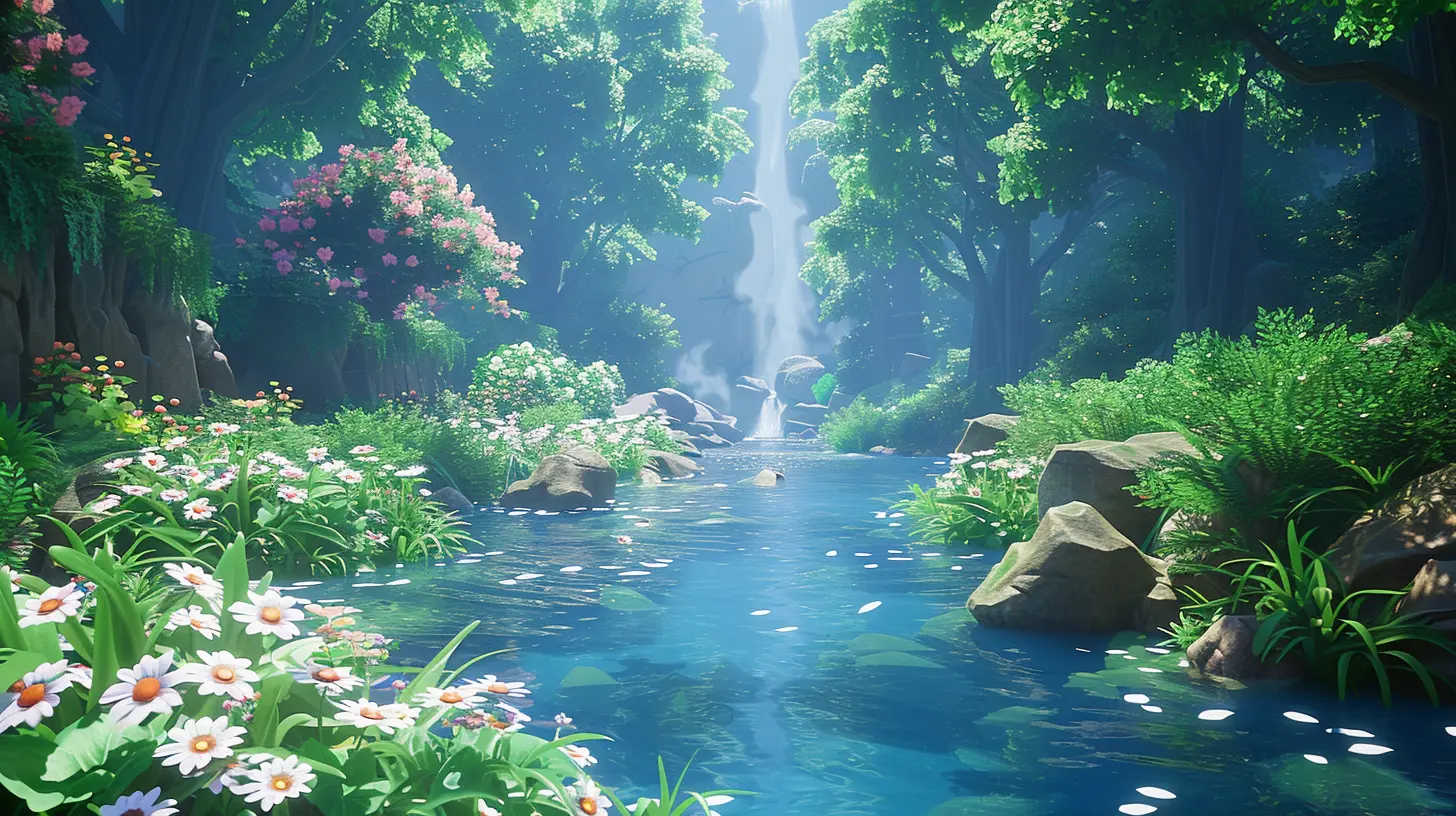How to Build a Solid Game Engine Portfolio as a Novice Developer
18 November 2025
So, you’re diving headfirst into the world of game development, huh? That’s awesome! But wait—building a game engine portfolio, especially as a newbie, might sound like you’re about to climb Mount Everest barefoot. Here’s the thing: it’s not as terrifying as it sounds. With the right mindset, tools, and a sprinkle of strategy, you can craft a portfolio that screams, "Hey, I’m serious about this!" Let’s break it down step by step and make this process not just achievable, but dare I say… fun! 
Why Does a Game Engine Portfolio Matter?
Imagine you're an artist showcasing your paintings, or a chef presenting their signature dishes. Would anyone take you seriously without something to show for your expertise? Building a game engine portfolio as a developer works the same way. It’s your proof of competence—a collection of your hard work that shows employers or collaborators, “Look what I can do!”But here’s the kicker: a portfolio isn’t just about showing your final products. It’s about painting a story of your skills, creativity, and the journey you've taken to improve yourself. This is especially important when you’re new to the field since you’re essentially saying, “Hey, I may not be a pro just yet, but I’ve got potential, passion, and proof to back it up!” 
Step 1: Start With the Basics (aka Your Learning Foundation)
Before you think about crafting a fancy portfolio, let’s get the groundwork sorted. You wouldn’t build a house without a solid foundation, right? Same deal here.Learn the Core Skills
To craft even a basic game engine, you need to master these essentials first:- Programming Languages: C++ and Python are the heavy-hitters in game engine development. C++ is like the Swiss Army knife: powerful but a bit tricky to handle at first. Python, on the other hand, is user-friendly and a great starting point. Focus on one and gradually add the other to your arsenal.
- Math & Physics: Don’t panic, I’m not asking you to solve quantum equations. But understanding vectors, matrices, and basic physics is crucial since they play a huge role in game mechanics (like gravity, collisions, etc.).
- Rendering Basics: Learn the basics of 2D and 3D rendering to understand how games visually come to life. OpenGL or DirectX will make your résumé shine.
Start Small
Don’t shoot for the moon right away. You’re not trying to build "Unreal Engine 6" on Day 1, okay? Begin with baby steps—create a simple physics engine or experiment with collision detection. These small wins will boost your confidence and give you something tangible to showcase.
Step 2: Choose Projects That Show Range
Here’s the deal: variety is king when building a portfolio. If all your projects fall under the same category, your portfolio might feel like that one playlist on repeat—stale and monotonous.Mix It Up
- Something Simple: Create a basic 2D engine to demonstrate your foundational skills. Think Pong-level simplicity here.- A 3D Challenge: Even a simple 3D environment can show employers you’re not afraid to go the extra mile.
- Specialized Systems: Dive into sound engines, physics engines, or AI systems. This shows off your versatility.
By diversifying your portfolio, you prove that you can handle challenges from different aspects of game development.
Be Honest About What You Can Do
Look, we’ve all been tempted to overhype ourselves. But it’s way better to showcase smaller projects you’ve actually nailed rather than something half-baked and overly ambitious. Quality over quantity, always.
Step 3: Document Everything (Seriously, EVERYTHING)
Your portfolio isn’t just about the final product—it’s about the journey. Think of it like behind-the-scenes footage of a blockbuster movie. People love knowing how the magic happened.Show Your Process
For every project, include notes, diagrams, or even short videos explaining how you went from “idea” to “result.” Include:- Sketches/Concepts: Did you brainstorm ideas on paper or a whiteboard? Take pictures!
- Code Breakdowns: Share snippets of your code along with commentary on what it does and why you wrote it that way.
- Challenges: Talk about problems you faced and how you solved them. This humanizes you and speaks volumes about your problem-solving skills.
Use Version Control
If you’re not already using GitHub (or similar), what are you waiting for? It’s like a public diary for developers—you’ll track your progress and show employers you’re organized. Upload your work there and keep it neat. Pro tip? Write clear README files for each project to guide viewers through your work.Step 4: Build a Portfolio Website
In today’s digital world, resumes are cool and all, but a website? Now that’s next-level. It’s your personal billboard, a place to visually and interactively showcase your skills.Pick a Platform
Not a web developer? No problem. Use tools like:- Wix or Squarespace: Super user-friendly and great for drag-and-drop customization.
- GitHub Pages: If you’re feeling a little geekier and want to stay free.
- WordPress: Offers a ton of flexibility and plugins.
What to Include
Your portfolio website should include these essentials:- About Me: Share who you are, your goals, and why you’re passionate about game engines.
- Your Work: Showcase your projects with detailed breakdowns (as mentioned earlier).
- Contact Info: Make it super easy for people to reach you (add your email, LinkedIn, Twitter handle, etc.).
Add a little flavor too—use your own voice in the writing. Don’t make it sound like a boring corporate profile. Show off your personality!
Step 5: Network Like a Pro
Wait, networking? Isn’t this supposed to be about portfolios? Stick with me…Your portfolio is like an epic sword, but without networking, you’re basically swinging it in an empty room. You need people to see it.
Join Online Communities
There are tons of online spaces where game developers hang out:- Reddit: Subreddits like r/gamedev and r/gameenginedev are a goldmine.
- Discord: Many game dev communities have active servers where you can learn and share.
- Twitter (X): Follow game devs, share your projects, and engage in conversations.
Attend Events
Whether it’s local hackathons, meet-ups, or global events like GDC, meeting people in person can do wonders. Bring business cards (you’d be surprised how far that little gesture can go).Step 6: Seek Feedback
Building a portfolio in isolation is like baking a cake and never letting anyone taste it. Feedback is your greatest tool for growth.- Ask for Critiques: Show your projects to peers or mentors and ask, “What could I improve?” Be ready for some tough love—it’s worth it.
- Iterate Constantly: Take feedback seriously and polish your projects. Development is all about iteration.
Remember, even the world’s greatest developers were once amateurs. Use feedback as fuel to get better.
Step 7: Stay Consistent
Rome wasn’t built in a day, and neither will your portfolio. Don’t pressure yourself to have a 10/10 portfolio overnight—it’s a marathon, not a sprint.Keep Adding Projects
Each new project you work on is another notch in your belt. Aim to update your portfolio every few months. Over time, it’ll evolve into something truly impressive.Track Your Growth
When you feel stuck, look back at your older projects. It’s like looking at your old school photos and realizing how far you’ve come (awkward hairstyles and all). Progress is progress, no matter how small.Final Thoughts
Building a solid game engine portfolio as a novice developer isn’t just about code or cool visuals—it’s about telling a story. Your story. It’s about showing that you’re willing to learn, challenge yourself, and create something amazing from scratch.Sure, it takes time, effort, and maybe a few late-night coffee-fueled coding sessions. But trust me, once you’ve got that portfolio ready to go, you’ll look back and realize it was totally worth it. So, what are you waiting for? Put on your metaphorical armor and get crafting!
all images in this post were generated using AI tools
Category:
Game EnginesAuthor:

Avril McDowney

